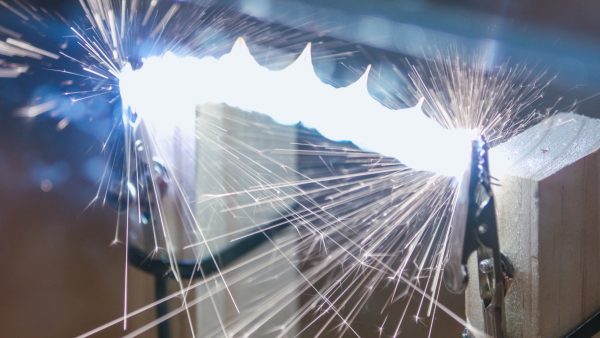Batteries Definition
Batteries convert chemical energy into electrical energy to power devices. For example, they can be the source of energy in an electrical circuit.
View Lesson on Electricity & Circuits
Become a member to get full access to our entire library of learning videos, reading material, quiz games, simple DIY activities & more.
Become a member to get full access to our entire library of learning videos, quiz games, & more.
Plans & Pricingto watch this full video.

Access All Videos
and Lessons, No Limits.
Access All Videos

No credit card required,
takes 7 sec to signup.
No card required

Ready-to-go lessons
that save you time.
Ready-to-go lessons
If you are on a school computer or network, ask your tech person to whitelist these URLs:
*.wistia.com, fast.wistia.com, fast.wistia.net, embedwistia-a.akamaihd.net
Sometimes a simple refresh solves this issue. If you need further help, contact us.
Electricity & Circuits
Fun Facts
- You can make a battery out of coins to power an LED!
- Volts measure a battery's potential energy; higher volts mean more energy.
- You could use a higher or lower volt battery to control the spin of a motor.
Why Do We Need To Know About Batteries
Learning about batteries helps us understand how they power things like toys. Batteries are important because they make a lot of our everyday gadgets work, from electric cars to our smartphones.
Batteries are also key in medical tools like artificial arms and in creating new computer technology. This shows how batteries are not just useful for powering things we use every day but also play a big part in creating new jobs and tech advancements in many areas.
Frequently Asked Questions
Check out the Full Lesson on Electricity & Circuits
In this lesson, we learn that:
- Electricity is the flow of electrical energy from one place to another.
- Electricity flows through conductors, but it cannot flow through insulators.
- A closed circuit is needed for electricity to flow and power our electronics.
Related Topics
- Adaptation Definition
- Astronomy Definition
- Batteries Definition
- Binary Code Definition
- Camouflage Definition
- Circuit Definition
- Climate Definition
- Comparative Anatomy Definition
- Condensation Definition
- Conduction Definition
- Conductor Definition
- Convection Definition
- Electric Charge Definition
- Electricity Definition
- Energy Definition
- Engineering Definition
- Evaporation Definition
- Fossil Record Definition
- Groundwater Definition
- Insulator Definition
- Invasive Species Definition
- Landslide Definition
- Lever Definition
- Limited Resource Definition
- Matter Definition
- Mutualism Definition
- Natural Disaster Definition
- Newton’s 2nd Law Of Motion Definition
- Newton’s 3rd Law Of Motion Definition
- Period Definition
- Physical Change Definition
- Physical Map Definition
- Precipitation Definition
- Prey Definition
- Rain Gauge Definition
- Reversible Change Definition
- Rock Definition
- Salt Water Definition
- Solubility Definition
- Species Definition
- Star Definition
- Sunlight Definition
- Temperature Definition
- Volts Definition
- Water Erosion Definition
- Water Quality Definition
- Wave Definition
- Wedge Definition


Start a Free Trial Today. Get a $5 Amazon Gift Card!
Teachers! Start a free trial & we'll send your gift card within 1 day. Only cards left. Try it now.
Select Grade
Select Subject
This email is associated with a Science Kit subscription. Kit subscriptions are managed on this separate page: Manage Subscription

-
Download InvoiceScience & Math$/yr
-
Download InvoiceScience Only$/yr

access all lessons
• No credit card required •
"My students loved the videos. I started the video subscription in May and used them as a review before the state test, which I know contributed to 100% of my class passing the state test."
Rhonda Fox 4th Grade Teacher, Ocala, Florida
Use Generation Genius in Your School
Access all lessons free for 30 days.
"My students loved the videos. I started the video subscription in May and used them as a review before the state test, which I know contributed to 100% of my class passing the state test."
Rhonda Fox 4th Grade Teacher, Ocala, Florida
• No credit card required •
Already a member? Sign In
* no credit card required *

* no credit card required *
* no credit card required *

Get District Quote
Discounts start at 3 schools.
Sent!
Thank you for your inquiry.
We will email you a quote as soon as we can.

to Discover the Benefits of Generation Genius
Learn How to Save for Your School & District!
Please login or create an account to access additional resources

no credit card required
Skip, I will use a 3 day free trial
Enjoy your free 30 days trial
-
Unlimited access to our full library
of videos & lessons for grades K-5. -
You won’t be billed unless you keep your
account open past your 14-day free trial. -
You can cancel anytime in 1 click on the
manage account page or by emailing us.
-
Unlimited access to our full library of videos & lessons for grades K-5.
-
You won't be billed unless you keep your account open past 14 days.
-
You can cancel anytime in 1-click on the manage account page.
Cancel anytime in 1-click on the manage account page before the trial ends and you won't be charged.
Otherwise you will pay just $10 CAD/month for the service as long as your account is open.
Cancel anytime on the manage account page in 1-click and you won't be charged.
Otherwise you will pay $10 CAD/month for the service as long as your account is open.
We just sent you a confirmation email. Enjoy!
Done



























































































































 GENERATION GENIUS
GENERATION GENIUS